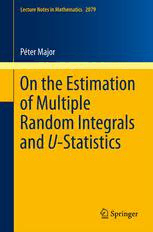Table Of ContentLecture Notes in Mathematics 2079
Péter Major
On the Estimation
of Multiple
Random Integrals
and U-Statistics
Lecture Notes in Mathematics 2079
Editors:
J.-M.Morel,Cachan
B.Teissier,Paris
Forfurthervolumes:
http://www.springer.com/series/304
Pe´ter Major
On the Estimation
of Multiple Random Integrals
and U-Statistics
123
Pe´terMajor
Alfre´dRe´nyiMathematicalInstitute
HungarianAcademyofSciences
Budapest,Hungary
ISBN978-3-642-37616-0 ISBN978-3-642-37617-7(eBook)
DOI10.1007/978-3-642-37617-7
SpringerHeidelbergNewYorkDordrechtLondon
LectureNotesinMathematicsISSNprintedition:0075-8434
ISSNelectronicedition:1617-9692
LibraryofCongressControlNumber:2013939618
MathematicsSubjectClassification(2010):60H05(StochasticIntegral)60G60(Randomfields)
60F10(Largedeviations)
(cid:2)c Springer-VerlagBerlinHeidelberg2013
Thisworkissubjecttocopyright.AllrightsarereservedbythePublisher,whetherthewholeorpartof
thematerialisconcerned,specificallytherightsoftranslation,reprinting,reuseofillustrations,recitation,
broadcasting,reproductiononmicrofilmsorinanyotherphysicalway,andtransmissionorinformation
storageandretrieval,electronicadaptation,computersoftware,orbysimilarordissimilarmethodology
nowknownorhereafterdeveloped.Exemptedfromthislegalreservationarebriefexcerptsinconnection
with reviews or scholarly analysis or material supplied specifically for the purpose of being entered
and executed on a computer system, for exclusive use by the purchaser of the work. Duplication of
this publication or parts thereof is permitted only under the provisions of the Copyright Law of the
Publisher’slocation,initscurrentversion,andpermissionforusemustalwaysbeobtainedfromSpringer.
PermissionsforusemaybeobtainedthroughRightsLinkattheCopyrightClearanceCenter.Violations
areliabletoprosecutionundertherespectiveCopyrightLaw.
Theuseofgeneraldescriptivenames,registerednames,trademarks,servicemarks,etc.inthispublication
doesnotimply,evenintheabsenceofaspecificstatement,thatsuchnamesareexemptfromtherelevant
protectivelawsandregulationsandthereforefreeforgeneraluse.
While the advice and information in this book are believed to be true and accurate at the date of
publication,neithertheauthorsnortheeditorsnorthepublishercanacceptanylegalresponsibilityfor
anyerrorsoromissionsthatmaybemade.Thepublishermakesnowarranty,expressorimplied,with
respecttothematerialcontainedherein.
Printedonacid-freepaper
SpringerispartofSpringerScience+BusinessMedia(www.springer.com)
Preface
Thislecturenotehasafairlylonghistory.Itsstartingpointwasanattempttosolve
some limit problems about the behaviour of non-linear functionals of a sequence
ofindependentrandomvariables.Theseproblemscouldnotbesolvedbymeansof
classicalprobabilisticmethods.I triedto solvethemwith thehelpof somesortof
Taylorexpansion.Theideawastorepresentthefunctionalweare investigatingas
a sum with a leading term whose asymptotic behaviour can be well described by
means of classical results of probability theory and with some error terms whose
effect is negligible. This approach worked well, but to bound the error terms I
neededsomenon-trivialestimates. Theproofoftheseestimateswas interestingin
itself,itwasaproblemworthofacloserstudyonitsownright.SoItriedtowork
outthedetailsandtopresentthemostimportantandmostinterestingresultsImet
duringthisresearch.Thislecturenoteistheresultoftheseefforts.
TosolvetheproblemsImetIhadtogiveagoodestimateonthetaildistribution
of the integral of a function of several variables with respect to the appropriate
power of a normalizedempirical distribution. Beside this I also had to consider a
generalizedversionof this problemwhen the tail distributionof the supremumof
such integrals has to be bounded. The difficulties in these problems concentrate
aroundtwopoints.
(a) We consider non-linear functionals of independentrandom variables, and we
havetoworkoutsometechniquestodealwithsuchproblems.
(b) Theideabehindseveralargumentsistheobservationthatindependentrandom
variables behave in many respects almost as if they were Gaussian. But we
have to understand how strong this similarity is, and when we can apply the
techniquesworked outfor Gaussian randomvariables.Beside this we have to
findmethodstodealwithourproblemsalsoinsuchcaseswhenthetechniques
relatedtoGaussianandalmostGaussianrandomvariablesdonotwork.
Todealwithproblem(a)Ihavediscussedthetheoryofmultiplerandomintegrals
and their most important properties together with the properties of the so-called
(degenerate)U-statistics.IconsideredtheWiener–Itoˆ integralswhicharemultiple
Gaussian type integralsand providea usefultool to handle non-linearfunctionals
v
vi Preface
of Gaussian sequences. I also provedsome results abouta good representationof
theproductofWiener–Itoˆ integralsordegenerateU-statisticsasasumofWiener–
Itoˆ integrals or degenerate U-statistics. A comparison of these results indicates
some similarity betweenthe behaviourof Wiener–Itoˆ integralsand degenerateU-
statistics. Itried topresenta fairlydetaileddiscussionof Wiener–Itoˆ integralsand
degenerateU-statisticswhichcontainstheirmostimportantproperties.
Problem (b) appeared in particular in the study of the supremum of a class of
random integrals. It may be worth mentioning that there is a deep theory worked
out mainly by Michel Talagrand which gives good estimates in such problems, at
leastinthecaseifonlyonefoldintegralsareconsidered.Itturnedouthoweverthat
the results and methodsof this theoryare not appropriateto provesuch estimates
thatI neededin this work. Roughlyspeaking,the problemsI methave a different
character than those investigated in Talagrand’s theory. This point is discussed in
moredetailinthemaintextofthiswork,inparticularinChap.18,whichgivesan
overviewoftheproblemsinvestigatedinthisworktogetherwiththeirhistory.The
problemsgetevenharderifthesupremumnotonlyofonefoldbutalsoofmultiple
randomintegralshastobeestimated.Heresomenewmethodsareneededwhichwe
canfindbyrefiningsomesymmetrizationargumentsappearinginthetheoryofthe
so-calledVapnik–Cˇervonenkisclasses.
I have also considered an example in Chap.2 which shows how to apply the
estimates proved in this work in the study of some limit theorem problems in
mathematicalstatistics.Actuallythiswasthestartingpointoftheresearchdescribed
in this work. I discussed only one example, but I consider it more than just an
example.Mygoalwastoexplainamethodthatcanhelpinsolvingsomenon-trivial
limitproblemsandtoshowwhytheresultsofthislecturenotesareusefulintheir
investigation.I thinkthatthisapproachworksin a verygeneralsetting, butthisis
thetaskoffutureresearch.Letmealsoremarkthattounderstandhowthismethod
works and how to apply it one does not have to learn the whole material of this
lecturenote.ItisenoughtounderstandthecontentoftheresultsinChap.8together
withsomeresultsofChap.9aboutthepropertiesofU-statistics.
I had two kinds of readers in mind when writing this lecture note. The first
kindofthemwouldliketolearnmoreaboutsuchproblemsinwhichrelativelyfew
independenceisavailable,andasaconsequencethemethodsofclassicalprobability
theory do not work in their study. They would like to acquire some results and
methods useful in such cases, too. The second kind of readers would not like to
gointothedetailsofcomplicated,unpleasantarguments.Theywouldrestricttheir
attentiontosomeusefulmethodswhichmayhelptheminprovingthelimittheorem
problems of probability theory they meet also in such cases when the standard
methodsdonotwork.Thislecture notecanbe consideredas anattemptto satisfy
thewishesofbothkindsofreaders.
Preface vii
Acknowledgement
This research was supported by the Hungarian National Foundation for Science
(OTKA)undergrantnumber91928.
Budapest,Hungary Pe´terMajor
January2013
Contents
1 Introduction................................................................. 1
2 MotivationoftheInvestigation:DiscussionofSomeProblems........ 5
3 SomeEstimatesAboutSumsofIndependentRandomVariables..... 15
4 OntheSupremumofaNiceClassofPartialSums..................... 21
5 Vapnik–CˇervonenkisClassesandL2-DenseClassesofFunctions.... 35
6 The ProofofTheorems4.1and4.2ontheSupremum
ofRandomSums............................................................ 41
7 TheCompletionoftheProofofTheorem4.1............................ 53
8 FormulationoftheMainResultsofThisWork......................... 65
9 SomeResultsAboutU-statistics.......................................... 79
10 MultipleWiener–Itoˆ IntegralsandTheirProperties................... 97
11 TheDiagramFormulaforProductsofDegenerateU-Statistics...... 121
12 TheProofoftheDiagramFormulaforU-Statistics.................... 139
13 TheProofofTheorems8.3,8.5andExample8.7....................... 151
14 ReductionoftheMainResultinThisWork............................. 169
15 TheStrategyoftheProoffortheMainResultofThisWork.......... 181
16 ASymmetrizationArgument.............................................. 191
17 TheProofoftheMainResult ............................................. 209
18 AnOverviewoftheResultsandaDiscussionoftheLiterature....... 227
ix

